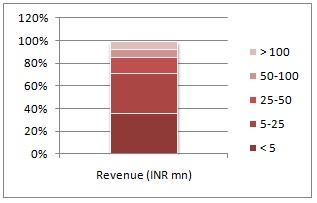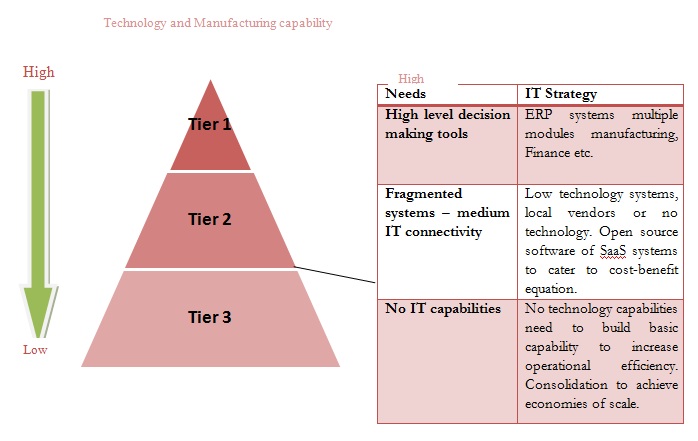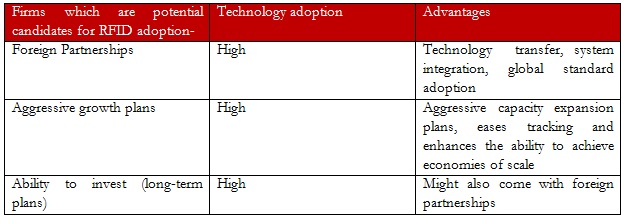Scope for RFID Implementation in the Indian Auto Components Industry
Faculty Contributor : Haritha Saranga, Associate Professor
Student Contributors : Tejas Dave and A. T. Shubha
The Indian auto components industry is gaining significance on the global front for the foreign Original Equipment Manufacturers (OEMs) that source parts from India. Adoption of global best practices is shaping the industry towards having an efficient supply chain system to fully exploit the rise in local demand. However, the industry is structured in three tiers with the lowest tier being highly fragmented. Information Technology (IT) solutions are thus necessary to increase the visibility across the supply chain to provide accurate demand forecasts, prevent counterfeiting of products and provide quality products and services. This article looks into the feasibility of using a Radio Frequency Identification (RFID) based system to integrate automobile supply chains in India.
The penetration rate of cars in India is only 7-8/1000 compared to 800/1000 in USA. As per a McKinsey survey the middle class in India will grow from 50 million to 550 million by 2025 coupled with rise in disposable incomes1. Statistics aside there are other market drivers which point towards India being an important market for OEMs. India emerging as the small car hub with Tata Nano being introduced as well as heavy investments by foreign OEMs in India indicates a bright future for the Indian automobile industry.
The Indian Automotive Sector
The Indian components manufacturers can be broadly divided into the organized and the unorganized sector with the organized sector accounting for close to 75% of the total production. As can be seen in Exhibit 1, majority of the players (~70%) have turnover less than INR 25 million.
 Exhibit 1: Profile of Organized Players by Turnover
Exhibit 1: Profile of Organized Players by Turnover
The components industry has an estimated turnover of INR 1200 billion for 2009-2010. As per the Automotive Mission Plan 2016 the potential CAGR for the component industry from 2008 to 2015 is slated at 11% with exports growing at 27% during the same time period2. The Indian Government along with SIAM (Society of Indian Automobile Manufacturers) and ACMA (Automotive Components Manufacturers’ Association) project an optimistic outlook for the industry, wherein by 2016 the Automotive Sector is supposed to contribute 10% of India’s GDP and approximately 35% of Industry.
The auto components industry is highly dependent on the OEMs. This leads to pressure from the OEMs for implementation of standards in terms of quality and delivery reliability which impacts the investments in this sector. This has necessitated a shift in the Indian market from being a low value-low quality supplier to one that meets stringent OEM standards. Besides, with higher value component designing and manufacturing being shifted to India3, there is a strong case for the local manufacturers to adopt global technology and delivery standards. Thus, for an OEM, coordinating across various regions is a challenge requiring innovation in Supply Chain Management.
Tier Structure and IT Strategy
The Indian auto component industry has three tiers. Tier I comprises of large firms that supply to major OEMs, followed by medium sized firms in Tier II and small single component manufacturers in Tier III as explained in Exhibit 2.
 Exhibit 2: Indian Auto component industry- Tier Structure and IT strategy
Exhibit 2: Indian Auto component industry- Tier Structure and IT strategy
The technology and manufacturing capabilities of each tier are different. Tier I suppliers are usually technology conversant and employ advanced manufacturing processes; they are globally competent in every respect. On the other hand, Tier II and Tier III suppliers have low level manufacturing and technology capabilities. This heterogeneity in IT needs further complicate the Indian auto component industry landscape.
Challenges for the Indian Auto Components Industry
There are three challenges faced by the auto components industry that can be addressed using RFID technology.
Counterfeit Products
Close to 30-35% of the total aftermarket products sold in India are counterfeit. The monetary value of these products was close to INR 63 billion in 2010 and is expected to go up to INR 140 billion in 20154. These products look remarkably similar to the original parts as observed in the case of Bosch recently5. There are three main losses associated with counterfeit products –
- Customer suffers due to bad quality components
- OEMs lose out on rightful business and also take a hit on reputation if the counterfeit products cause problems to the customers
- Government loses close to USD 350 million annually on the sale of counterfeit products due to duty evasion6
Increasing Insurance Premium to Cover Product Recall Liability
Globally product recalls have stretched OEM reputation as well as financials. For instance the Toyota sudden acceleration related recall in recent times could cost the company close to $ 2 billion7. Even in India, Maruti Suzuki has to recall close to 100,000 cars for faulty parts in its A Star model8. Product recalls are covered by general insurance companies which typically charge 1-1.5% as premium for limit of liability. One of the main reasons for such inflated numbers is that OEMs lack the ability to track the major components that go in making a vehicle on a per vehicle basis and thus, they are forced to recall entire product lots instead of only the faulty products.
Just-In-Time (JIT) Implementation Issues and Technology Adoption
Enterprise Resource Planning (ERP) systems that integrate the various players in the supply chain have not been completely adopted in India. One of the main reasons is that at the Tier 2 level the industry is very fragmented. This leads to automakers finding it difficult to access reliable information and dealing with different information storing and processing systems9. The lack of standardization leads to opacity in the supply chain thereby affecting forecasts at each stage.
Using RFID to Solve Current Challenges
Existing RFID products in the market cover three major processes that impact automobile supply chains and can possibly address the challenges mentioned above.
- Outbound and Inbound logistics can be automated, where sub processes such as generating serial numbers, commissioning and associating RFID tags with components, tracking shipments, automatically triggered advanced shipment notices can be handled by the RFID solution.
- Track and Trace Process can be used to authenticate genuine parts in the supply chain and this reduces product recall liability.
- Kanban Process, which has traditionally been a manual process, gets automated using RFID. It eases JIT implementation for parts manufacturers as well as OEMs.
Dispelling the “Very Expensive” Notion
An elementary business case, as shown in Exhibit 3, shows that implementing a RFID based system can prove profitable to the industry. Only counterfeiting losses are considered. When the losses are spread across the entire organized sector then the average loss turns out to be INR 107 million, whereas the loss to players with revenue more than INR 50 million is close to INR 759 million.
The cost of the RFID system for implementing in a large manufacturing plant ranges from INR 585 million to INR 1035 million. Assuming that only the big players have IT readiness to invest in such a system, we see that the costs are approximately 7 times that of money lost to counterfeit sales. However, this does not include the gain in productivity from an organized supply chain, money saved on warranty replacements, reduction in product recalls and potential to provide value based services. Also, it is not necessary that all the players in the industry have to implement the same scale system. Since it is a supply chain connecting various levels and vendors there is a high possibility of overlap.
 Exhibit 3: Elementary Business Case10
Exhibit 3: Elementary Business Case10
Recommendations to RFID Solution Providers
Lobby with Government for Compliance
In the American market the enactment of the TREAD Act forced OEMs to track the major components in the vehicle through the supply chain. Almost 11% of the suppliers adopted the technology to comply with the regulations11. This is to ensure greater accountability on the part of the OEMs. The Indian auto components industry is moving towards implementing a larger number of electrical parts. As per a study by CSM12, airbags would be mandated in each vehicle by 2012-2013. Airbags require airbag sensors which are a critical safety component. Implementation of such measures will force Indian suppliers and OEMs to invest in a track and trace solution.
Customize Offering to Suit Indian Conditions
Research indicates that RFID based systems are not currently in demand. Firstly, because the stringent regulations that exist elsewhere are not prevalent in India hence the suppliers are not forced to conform to a particular standard. Secondly, even though RFID based solutions have been implemented in high value OEMs such as Volkswagen, BMW, and Daimler in the West, the same response cannot be expected in India. Reason being, high value cars in India are still at a nascent stage. The volumes do not justify the costs for investing in such a system. The solution needs to be customized to Indian requirements.
Target OEM’s/Auto Component Manufacturers
Exhibit 4 shows that companies that have foreign collaboration (either through a majority stake or through partnerships) are more technology savvy, and face a harder push from the foreign arm towards technology adoption, are likelier candidates for RFID adoption. Besides, if the parent has already implemented RFID technology in the home country it definitely adds credibility and eases the change for the Indian counterpart.
 Exhibit 4: Potential customers for RFID solution
Exhibit 4: Potential customers for RFID solution
Conclusion
The Indian auto components industry is poised to grow at high rates and cater to demands from global as well as local OEMs. Increasing complexity in the parts that go into a car combined with the multiple vendors sourcing by OEMs does put a strain on the supply chain. In India owing to the fragmented nature of the industry at the lower tiers, lower emphasis on compliance and very high cost consciousness make implementation of new technology such as RFID for increasing operational efficiency a difficult game. The emphasis needs to be on clear cost benefit to the suppliers.
Keywords
Operations, Supply Chain, Automobile Industry, RFID
Contributors
Haritha Saranga is an Associate Professor in the Production and Operations Management Area at IIM Bangalore. She has a Ph.D. in Reliability Engineering from the University of Exeter, UK and can be reached at harithas@iimb.ernet.in.
Tejas Dave (PGP 2009-2011) holds a Bachelor's Degree in Electronics Engineering from University of Texas, Dallas. He can be reached at tejas.dave09@iimb.ernet.in.
A.T. Shubha (PGP 2009-2011) holds a Bachelor’s degree in Information Technology from Manipal Institute of Technology, Karnataka. She can be reached at shubha.a09@iimb.ernet.in.
References
- “Trends and Opportunities in the Indian Automotive Sector”; Mr. Deepak Kapuria; 2009
- “Trends and Opportunities in the Indian Automotive Sector”; Mr. Deepak Kapuria; 2009
- “The Indian Automotive Components Industry - Forecasts to 2014.” http://www.thefreelibrary.com/The+Indian+Automotive+Components+Industry+-+Forecasts+to+2014.-a0168650173Last Accessed on: Oct 09, 2010
- “Sectorwise break-up of counterfeit products”; Financial Express; http://www.financialexpress.com/news/Sectorwise-breakup-of-counterfeit-products/517135/Last Accessed on: Oct 09, 2010
- “Fake auto parts of Bosch found at Auto Expo”; Business Standard; Jan 12, 2010; http://www.business-standard.com/india/news/fake-auto-partsbosch-found-at-auto-expo/382443/Last Accessed on: Oct 09, 2010
- “Fake auto parts cost exchequer $350m a year”; Financial Express; Jan 08 2010; http://www.financialexpress.com/news/fake-auto-parts-cost-exchequer-350m-a-year/564745/Last Accessed on: Oct 09, 2010
- “Toyota Recall costs $2bn” Feb 04,2010; CNN Money; http://money.cnn.com/2010/02/04/news/companies/toyota_earnings.cnnw/?postversion=2010020410Last Accessed on: Oct 09, 2010
- “Total Recall: product liability in India”; Economic Times; Apr 25, 2010; http://economictimes.indiatimes.com/articleshow/5854623.cmsLast Accessed on: Oct 09, 2010
- “Importance of ERP in the auto component industry in India - reality and challenges” ; Jul 19,2010; http://www.articlesbase.com/software-articles/importance-of-erp-in-the-auto-component-industry-in-india-reality-and-challenges-2854707.htmlLast Accessed on: Oct 09, 2010
- RFID an enabler of supply chain operations, Mohsen Attaran; November 2007
- “Parts tracing drives automotive supply chain: government regulations and rising recall costs force suppliers to get a better handle on parts data”; http://findarticles.com/p/articles/mi_m0DIS/is_3_6/ai_n15759603/?tag=content;col1Last Accessed on: Oct 09, 2010
- “India Challenges and Opportunities”; Bhargavi A. R.; CSM ;2009
